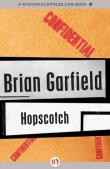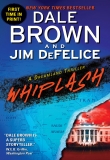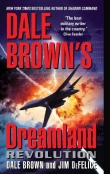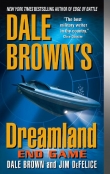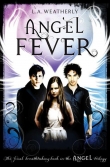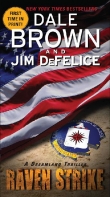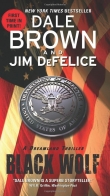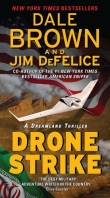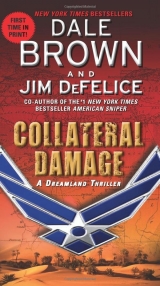
Текст книги "Collateral Damage"
Автор книги: Dale Brown
Жанры:
Боевики
,сообщить о нарушении
Текущая страница: 15 (всего у книги 25 страниц)
The odds were better to just keep it flying, he decided.
A few seconds later the screen on the control blanked. It had stopped transmitting. The Libyan gunfire had caught the aircraft.
There was a ground flare at the complex. For a brief moment Rubeo thought it was the aircraft crashing, but in fact it was an SA–10 missile launching. A second and then a third and fourth came off the ground in quick succession.
“It is time for us to leave,” announced the scientist. “Pack quickly.”
HESITATION
1
Over Libya
The A–10E helmet had a night vision attachment allowing the pilots to see in the dark. The combination was still lighter than the smart helmet, but it was awkward, tilting the helmet forward so the edges rubbed against Turk’s cheekbones.
The glasses turned the world into a crisp collection of greens and blacks, an alternate universe that lived parallel to the real one. It was as if the pilot was an electronic ghost, slipping through the dark solids before him.
While the technology was different, the view itself was familiar to Turk from the smart helmet, where it was one of the preset defaults, designed to make the transition from older technology to new as seamless as possible. He felt it was superior to the view offered in F–35 helmets—another preset. There was a sharpness to it that the Lightning II view seemed to lack.
Turk took Shooter Four up from the south runway, moving into a gradual climb over the Mediterranean. The four-ship flight’s first stop was a tanker track to the southwest; they would top off there before heading over Libya.
Turk listened as Ginella checked in with the AWACS, getting a picture of the situation over the country.
She was an odd case—professional to the point of cold indifference toward him in the squadron room, outrageously passionate in bed.
It confused the hell out of him.
Remembering Grizzly’s tales of tanker woe, Turk approached the boom gently, easing in at a crawl. At any second he expected the boomer to squawk at him about how slow he was going. But all he got was an attaboy and a solid clunk as the probe was shoved into the nose of the Hog.
He held the aircraft steady as the JP–8 sloshed in. The cockpit filled with the heady scent of escaping kerosene. Turk tried to relax his shoulder and arm muscles, afraid that any twitch would jerk him off the straw. By the time the boomer called over to tell him to disconnect, his arms had cramped.
“Copy that. Thanks.”
Turk slipped downward, dropping through several dozen feet before banking right and moving out and away from the tanker. The radio whispered hints of distant missions; it was a busy night over Libya, the allies keeping pressure on the government as the rebels continued with their offensive.
Grizzly had already tanked and was waiting for him.
“You did good, Turk,” said the other pilot. “Gonna make a real Hog driver out of you yet.”
“I’m getting there.”
“You gotta work on your grunts.” Grizzly made a noise somewhat similar to the sound of a rooting hog. His voice lost an octave and became something a caveman would have been proud of. “Real Hog driver talk like this.”
“All right, you two, knock it off,” said Ginella. “Let’s look sharp and keep our comments to business. Turk, how are your eyes?”
“I’m good.”
“There’s been no sign of our package south,” she added. “Let’s get there. You know the drill.”
Thirty minutes later the four Hogs approached an arbitrary point in the sky where they had been assigned to loiter. The other half of Shooter Squadron was to the southwest about seventy miles. The aircraft were flying at roughly 30,000 feet, high enough so they couldn’t be seen or heard in the dark night sky.
The American planes were part of a massive search and rescue operation. Dozens of aircraft were strung out across the country, ready. All they needed was a downed pilot.
The wreck had been located in a ravine twenty miles south. But the pilot’s locator beacon and radio had not been detected. Ground forces were conducting a search near the plane and in an area where computer simulations showed the man might have parachuted. Army Special Forces units had been inserted just after dusk, and had made contact with some rebels in the area who were helping with the search.
Turk didn’t have a lot of experience with rescue operations, but it took little more than common sense to realize that if the pilot hadn’t radioed in by now, the odds of finding him alive were extremely slim. But no one in the air wanted to mention that. It was too easy to put yourself in the downed man’s place—you didn’t want to think of giving up.
An hour passed. The other half of Shooter Squadron called it a night and headed home. Ginella led her group farther south, orbiting over two different spec op detachments.
Adrenaline drained, Turk found staying alert extremely difficult. He stretched his legs, rocked his shoulders back and forth—it was a constant battle, far more difficult than actually flying the plane.
One of the ground units reported that they were following a lead from the rebel guerrillas; the information was passed back down the line to the squadron. Turk felt his pulse jump. But when the lead failed to pan out, he found it even harder to keep his edge.
With dawn approaching, Ginella decided they would refuel so their patrol could be extended if needed. She split the group in two so they could continue to provide coverage. Grizzly and Turk went north to the tanker track while she and her wingman stayed south.
Mostly silent during their loops, Grizzly became animated as they approached the hookup. He told Turk he had brought along an iPod and was listening to music as they flew.
“Got some old stuff I haven’t heard in a while.”
The music may have been old, but Turk hadn’t heard any of it. It was country and country pop—Son Volt and Civil Wars and half a dozen other singers and groups completely off his radar.
“You gotta get out more,” laughed Grizzly when Turk confessed he’d never heard of the groups. He began filling him in, keeping the patter up all the way to the Air Force 757s.
“What do you think of G?” asked Grizzly after they had finished tanking.
“Seems OK,” said Turk as neutrally as possible.
“Real hardass sometimes. Good pilot, though. First woman commander I’ve ever had.”
“First one?”
“Probably had a female in charge of one of the schools somewhere along the way,” said Grizzly, referring to the different classes the officer would have attended. “But not, you know, like this.”
“Uh-huh.”
“Kinda different flying for a woman, you think?” said Grizzly.
It sounded somewhere between a statement and a question. Turk didn’t know how to answer it either way. His boss—Breanna Stockard—was a woman, but he wasn’t supposed to refer to Special Projects if possible, and he worried that mentioning her would inevitably point the conversation in that direction. It took him a few moments to think of something suitably neutral and bland to come back with.
“I haven’t worked with an actual squadron in a while,” he told the other pilot. “I’m pretty much a one-man shop.”
“That’s kind of cool.”
“Yeah.”
“Word is the Air Force is gonna phase us down,” said Grizzly. “Turn all the electronics in these suckers on and let them fly themselves.”
“I don’t know about that,” replied Turk.
“Probably replace us with laser jets, if not.”
Both ideas were actually plausible. A few years before, that would have sounded like science fiction or maybe fantasy. But there were in fact plans to replace the A–10 squadrons with airborne laser planes. The aircraft, modified from civilian airliners and housing high-energy weapons, could fly at a safe distance and altitude yet make attacks with pinpoint precision. It was almost guaranteed that a fleet of the laser jets, as they were called, would replace the Air Force’s small force of AC–130s in the next eighteen months.
“I think there’s a real need for people in the loop,” said Turk. “But, I don’t know.”
“I hear ya.”
“Everything’s going in the other direction,” said Turk.
“You’re part of it though, right? You’re playing with those little dart jets? Pretty soon they won’t need you either.”
Grizzly was absolutely right. He didn’t answer, though—because of his position, what would have been interpreted as a casual remark by any other person could be seen as a breach of security if he said it.
Maybe the accident would turn things back in the other direction. But it could just as easily be used as an argument against keeping a man in the loop—his being there, or being close, hadn’t stopped the Sabre from making the mistake.
The accident had grounded the Sabres, but not the rest of the UAV fleet. That in itself was statement of how important they were. Right now at least three were operating in the rescue area. Two provided a continuous infrared picture of the ground to the controllers and the team hunting for the pilot. The other was sniffing for his radio and signal beacon.
With a full belly—or more accurately, wing tanks—of fuel, Turk followed Grizzly in a loose trail south as the sun tiptoed toward the horizon. As the light strengthened, he removed the night goggles and left the augmented visor retracted, preferring to see the sky and aircraft as they truly were.
He had plenty of fuel, but this mission couldn’t go on forever. Eventually, the pilots’ fatigue would build to the point where they simply couldn’t trust themselves. To use one of the more formal terms and measures, situational awareness would degrade severely.
That was a problem one never had with computers.
“Shooter One, this is Three,” radioed Grizzly.
“One.”
“We’re about thirty minutes away. Anything?”
“Negative. Still on hold.”
“What do you want to do, G?”
“We’ll go tank when you’re here,” she told Grizzly. “Play it by ear from then.”
“Understood.”
“How’s your wingman?”
“Still there every time I turn around.”
“Four?” Ginella asked.
“Shooter Four is good,” said Turk.
“A little boring for you?” asked Ginella. Her voice had a hint—but only just a hint—of the more familiar tone she used when they were alone.
“I’ll survive.”
“That’s the spirit.”
“We covering the pickup of the search units?” Grizzly asked.
“Not sure yet,” answered Ginella. “Pickup has been delayed.”
“That’s a good thing.”
“Don’t jump to conclusions.”
“Just saying.”
The four Hogs joined up, flying in a large circular pattern above the desert. Ginella rebriefed Grizzly on contact frequencies and some of their protocols—all things Grizzly already knew. But he didn’t complain.
“We’ll be up and back as quickly as we can,” she told them. “There’s a flight of F–16s north for backup.”
“Roger that. Have a good trip.”
But before Ginella could check in with the controller, he radioed to tell them there was a flight of Blackhawk helicopters inbound. The IDs on the choppers belonged to the units tasked for the pilot’s rescue pickup.
“Groundhog has located the beacon,” explained the controller. “Stand by to cover a pickup.”
“In that case, we’ll hang down here,” Ginella told her squadron. “We have plenty of fuel for now.”
The A–10Es were vectored southwest, near a small settlement at the edge of a long, open square of desert. They waited until the helicopters were about five minutes away before going down to take a look; they didn’t want to call attention to their presence until absolutely necessary.
Ginella contacted Groundhog for an update on their situation. From the accent of the radioman, Turk guessed that the ground unit was a British SAS commando squad, one of a number of special operations troops operating in the theater. His communiqués were terse, with quick acknowledgments when Ginella responded.
The commandos were in a village isolated from the highway by a narrow winding road through a series of sharp but narrow hills. The village had no more than two dozen houses, and was centered around a pair of unpaved streets that came together in a Y at roughly the center of the settlement. A small mosque and minaret stood near the intersection on the southernmost street.
The helicopters were directed to hold at a position roughly ten miles away from the village.
The SAS troopers had located a very weak signal inside a building on the street north of the mosque. With all of their support elements in place, they were going to storm the building. If things went wrong, they wanted the Hogs in fast.
“Acknowledged, Groundhog,” Ginella told him. “You can count on us.”
Turk studied the image of the village in the multiuse screen. The nearby hills limited their attack approach to an east-west corridor above the main streets.
Once again Ginella split the flight into two elements, but kept both on the east side of the village. All the planes would fly in the same direction on the initial attack. After that, she and Coop would recover south while Grizzly and Turk would go north. The idea was that the two groups would be in position to attack anyone coming from the outside.
“We’ll play it as it develops,” she added.
Groundhog radioed that they were going in.
Turk felt his chest starting to tighten. Sweat began collecting under his gloves.
He told himself to relax, but his heart started thumping. His adrenaline level shot up—he was starting to feel a little jittery, as if he’d had a few pots of coffee. He knew he must be physically overtired, but his body seemed to be overcompensating.
Relax.
Relax, goddamn it.
The commandos used a special short-distance radio to talk among themselves; the Shooter aircraft couldn’t hear what they were saying.
Five minutes passed. The planes circled in the sky, waiting.
“Shooter One, Groundhog here. We’re moving south through the village.”
“Groundhog, say status.”
“We don’t have him.”
“Is he there? What’s going on?”
“We recovered some gear. We’re moving to the mosque.”
“Groundhog, do you require assistance?” asked Ginella.
“Negative. Hold your position.”
“Shooter One acknowledges. Holding position.”
“We oughta take a ‘low-and-slow’ and see what’s up,” said Grizzly. “Just let them know we’re here. At least shake ’em up a bit.”
“Negative,” snapped Ginella. “Just do what they want.”
“I wasn’t saying I was going to do it.”
“Silent coms,” she told him.
“Yes, ma’am.”
“I have a vehicle on the road, two vehicles,” said Coop. “You see these, Colonel?”
“Yes, roger that,” said Ginella. “Groundhog, be advised we’re seeing two pickup trucks with people in the truck beds. They’re approaching the road to your village.”
“Splash them.”
“Negative, Groundhog. That’s not in my ROEs.”
The ROEs—rules of engagement—permitted the Hogs to shoot at a target only if it presented an imminent danger to friendly forces or themselves. In this case, the men in the trucks would have to be firing at the commandos to justify aggressive action.
“We don’t need company,” said Groundhog.
“Understood, Groundhog. But we’re limited by our orders.”
Turk expected the British soldier to tell them what they could do with their orders. But he didn’t reply.
“Coop, follow me down,” she said.
The two Hogs dove toward the roadway, dropping precipitously. They rode in over the pickup trucks, accelerating and jerking away.
Ginella’s idea was clear—she was putting the fear of God, or rather Hogs, into them.
The trucks sped up, continuing past the turnoff for the village.
The two jets cleared north and came back around.
“I’m getting close to bingo,” said Coop.
“Acknowledged,” said Ginella. “Groundhog, what’s your status?”
“Working toward the mosque,” he replied.
“Do you have resistance?”
“Negative.”
They took a few more turns. Finally, Ginella admitted the inevitable.
“Groundhog, my wingmate and I are going to refuel. I’m turning you over to Shooter Three and Shooter Four. You’ll be in good hands.”
“Affirmative. Thanks, mate.”
Ten minutes later the SAS trooper radioed that they were going inside the mosque. He asked the two planes to fly over “loud and low”—exactly the distraction Grizzly had thought of earlier.
“We’re on the way,” said Grizzly. “Ten seconds.”
Turk came in off Grizzly’s right wing, his head swiveling as he searched the ground for some sign of resistance, or even life. The small village seemed completely deserted, with no one on the streets. Ordinarily the small towns had goats, dogs, or other animals wandering about. He saw nothing.
The two planes circled left, pulling up around one of the small hills. As they did, Turk caught a glint off something to his right. He raised himself in the seat, looking back over his shoulder.
“Hey, I think we got those trucks coming back,” he told Grizzly. “Got something on the road.”
“What is it?”
“Turning.”
Turk circled back to get a better look at the trucks. Grizzly contacted the airborne controller, trying to see if the Predator overhead could shift closer for an image. He then tried to contact Groundhog directly, to check on their status.
The Brits said only that they were “good.” By then the trucks had gone off the main highway, moving in a direct line toward the road that led to the village.
“Those the same trucks as before?” Grizzly asked.
“Can’t tell,” said Turk. “What about the Predator?”
“The trucks are a little far from the road for the Predator to spot. He has to stay eyes on the village.”
“By the time they’re in range they’ll be in the hills.” The geography would make it harder to watch the trucks there.
“Let’s get in their faces,” said Grizzly. “See if we can run them off like before. I’ll come in first. They fire at me, light them up.”
“Yeah, all right. Roger that.”
Grizzly led him south before banking and pushing down, his nose angling toward the pickups. Turk waited, giving the other plane enough of a head start so he could react if he saw anything. He tucked down, pushing the Hog through 1,500 feet and picking up speed.
He was on the back of a sleek stallion. The engines rushed behind him, a steady whoosh. He edged his finger on the trigger of the gun, double-checking the panel to make sure the weapon was ready.
The two trucks were no more than thirty yards apart. The lead vehicle was just reaching the road to the village as Shooter Three came in ahead of him, low.
Something winked below Grizzly’s A–10.
Gunfire?
Turk couldn’t tell if it was a muzzle flash or just a reflection from the sun.
Another glint. A flash.
Weapon. Guns. MANPAD!
“Flares! Evade!” yelled Turk, warning the other plane even as he pressed the trigger to zero out the threat.
The big gun in the nose of the A–10 began rotating. The force of the cannon was so intense that it seemed to hold the Warthog up in the sky. The burst lasted not quite two seconds, but in that time, somewhere over one hundred rounds burst from the gun. Nearly every one hit the truck—or would have, if there was truck left there to hit. The heavy slugs tore the front of the truck in half, igniting a huge fireball and vaporizing a good portion of the vehicle.
“Missile in the air!” yelled Grizzly.
Turk’s warning system was bleating as well, but he was too focused to pay attention. He leaned his body left and the jet followed, moving quickly as he lined up his second shot. He was a little too close to get more than a few slugs into the truck before he passed it, but they were more than enough to stop the vehicle.
Turk dished flares and turned hard right, himself a target now. Gravity hit him in the side of the face and chest. He felt the bladders in his flight gear pushing hard against his stomach and his legs. The Hog floated a bit, moving sideways as it struggled to sort out the conflicting demands of gravity and its pilot’s will.
The peak of the hill loomed dead ahead, a jagged slag of red and brown.
“Power, baby,” Turk said, his hand already slamming the throttle. “Power.”
The Hog’s nose pulled up and the aircraft lifted in the sky, almost hopping over the hilltop.
He felt weightless. He wasn’t sure what had been launched at him. He was afraid it was on his tail.
“ECMs,” he said, momentarily reacting as if he were in the Tigershark. He recovered quickly, hitting the panel to activate the electronic countermeasures—a fancy name for a radar jammer.
The Hog continued to climb for a few more seconds before Turk realized that whatever had been launched had missed. Either it had been sucked off by the flares or was unguided to begin with, just a rocket-propelled grenade. He banked back around.
The first truck was hidden by steam and smoke. The second was sitting on the side of the road.
He had it on his nose. He glanced up, locating Shooter Three on his left wing at about ten o’clock, coming up from the south.
“I’m going in on that second truck,” Turk called on the radio.
“Roger that.”
“You OK?”
“Yeah, yeah, I’m good, I’m good. Go for it—I got your six.”
The truck was fat in his windscreen. The men on the ground were firing at him—Turk could see their muzzles blinking.
One of his missiles would have wiped out all of the men, but he wanted to save them for the SAS unit. And in any event, he’d already made up his mind on how he was going to attack.
The truck grew large in his pipper. He pressed the trigger, spitting a steady stream of spent uranium into it.
The vehicle disappeared beneath a cloud of smoke. Turk cleared south.
“We’re good, we’re good,” said Grizzly. “Hold south of the village.”
“We need to move back east in case we have to run into the village,” said Turk.
“Yeah, all right, you’re right. Good—let’s get there. Follow me.”
As they pushed their aircraft back into a position that would make it easier to support the ground units, Groundhog checked in, asking what was going on.
“Just smoked two pickups that fired on us,” reported Grizzly.
“Copy.”
“What’s your situation?”
“We’re going through the building.”
“You have subject?”
“Negative.”
“We’re standing by.”
“Copy, Shooter.”
The brief engagement had been more physical than Turk realized. His arms and upper body felt as if he’d been in a boxing or MMA fight, sore and drained.
But his breathing was calm. The action had relaxed him.
Groundhog reported that there were people on the street.
“A lot of watchers,” said the British soldier.
“Threatening?” asked Grizzly.
“Negative. Just watchers. We’re moving to your south.”
A minute or two later he called back.
“We’re on the street,” said Groundhog. “Can you take a pass?”
“Stand by.”
“I’m with you,” Turk told Grizzly.
“Follow me through. Same game plan.”
“Let’s make it fast,” said Turk. “We don’t want to push our luck.”
“No shit on that.”
Turk dropped the Hog through four hundred feet as he came down. Grizzly was another hundred feet lower. He dropped to two hundred feet as they came over the village. Turk worried his wingman would plow into the buildings or the nearby hill, but he cleared them and rose south.
The flyover lasted only a few seconds, but each moment was a full day, weighted with tension. Turk looked left and right, heart pounding. He saw the broken edges of the roof tiles, a half-eroded garden wall on the largest house, a car that had lost its tires.
And he saw the tops of heads ducking, a bald man, two startled teenagers, a woman white with fear.
He punched the throttle, powering away.
“Wooo-hoo,” said Grizzly as they climbed. “You see that crowd?”
“Copy.”
“Weapons?”
Turk had to think about what he had seen. People moving, standing. Weapons?
None that he remembered. He tried processing it again.
“Negative. Not even rifles,” he added.
“You sure?”
“I think so. You see something?”
“No.” Grizzly sounded disappointed.
Groundhog began squawking. They were calling the helicopters in for a pickup.
“We’re moving to the south side of town,” said the SAS soldier. “Do you copy, Shogun Six?”
“Shogun Six copies.”
“Point is marked as Landing Four on your map. It’s behind a low wall.”
“Affirmative. We copy.”
Turk spotted the two helicopters flying from the north, crossing in a wide arc west of the hamlet. They were aiming at a field behind a large building.
“Got people in that building,” said the helicopter pilot.
“Are they aggressive?” asked the controller. “Weapons?”
“I just see people.”
A three-way conversation between the helicopters, the controller, and the ground unit ensued. The voices were quick and sharp as the men tried to determine whether the people in the building constituted a threat. No weapons had been spotted, and the ROEs declared that they be left alone. That seemed to be a relief to all concerned, especially the ground unit.
As a precaution, Turk noted the building. He could blast it with a missile if necessary.
The dozen members of Groundhog hopscotched down the street toward the landing point. Turk could see knots of people moving roughly parallel to the soldiers.
“A lot of people down here,” said Groundhog.
“We want to keep them as far back from the helicopters as possible,” said Shogun. “More Hog psyops.”
The helicopters touched down. The Brits fell into a dead run.
They were still twenty or thirty yards away when one of the helicopters jerked upward.
“Gun! Gun!” yelled someone over the radio.
Turk, about a half mile east of the pickup area, strained to see what was going on.
Grizzly radioed Groundhog and Shogun but got no answer. Bits of smoke appeared in a line on the ground about a hundred yards from the pickup area, near the village.
“Shogun’s firing,” said Grizzly.
“Hold back,” warned Turk. “Helicopter is circling.”
Turk had to bank to give the chopper room. Smoke spread across the field. It looked like something from a smoke grenade rather than gunfire.
“Groundhog? Groundhog!” said Grizzly. “Say your situation. What the hell is going on?”
The first helicopter circled south, ramping upward. The second helicopter remained on the ground.
“I don’t see any gunfire,” said Turk.
“I can take out that building,” said Grizzly.
“Negative, negative,” said Turk. “There’s nothing coming from there. Hold off.”
The blades on the second helicopter began rotating furiously. The helicopter rose upward, cutting across a thick fist of smoke.
“We’re good, we’re good,” Groundhog said. “All recovered.”
Turk lost sight of the helicopter as it passed behind him, flying northeastward. He found Grizzly on his left and followed him upward, climbing away from the village.
Barely two minutes had passed since the ground element began running for the choppers. It had been a tangle of confusion, at least from Turk’s point of view. He tried sorting it in his mind: the helicopter that lifted off had seen people coming and decided to hold them off with gunfire that missed but scared people away. The other chopper made the pickup, the trooper tossing smoke grenades behind to cover their retreat.
Simple. Assuming that was the way it went. It was hard to decipher even the most obvious action in combat.
The helicopters arced northward, getting away from the village. Turk started thinking about the long flight home—and how long he would sleep once he reached the hotel.
“This is Shogun Actual,” called the helicopter commander. “All allied assets, be advised. We have two men still on the ground. They are moving through the field at the north side of the village. Mountain Three is coming for a pickup.”
The men, providing an overwatch from the northern end of the village, had been separated as the units began exfiltrating. Confusion on the ground had sent the helicopters skyward before they reached the pickup point.
Damn.
The two SAS men on the ground were in radio contact with the controller. The men, using the call sign Rodent, were on the north side of the village. The helicopter pilot flying Mountain Three was closing in. He told them he would meet them wherever they wanted.
“Hell if necessary,” added the man, who had the slight lilt of a Boston accent.
They told him they would go north and meet him in the flat desert area. No one was following them.
The air controller, meanwhile, tried to gather more information about the crowd that had been following. The SAS men said they hadn’t seen any weapons, something Turk and Grizzly confirmed. But someone aboard the helicopter believed he had.
It was impossible to know the real facts. As a practical matter, the rules remained the same for the two A–10 pilots: they could watch, and buzz the crowd if necessary, but at the moment they couldn’t fire.
How strange it must be on the ground, Turk thought. A civilian in the war zone was a voyeur, an observer, maybe reluctant, maybe against his or her will. Yet the fascination to find out what was going on must be incredible.
You’d be drawn to the strangeness, if not the danger. The danger might not even seem real, because the situation was so bizarre—men with guns running through your village, a nightmare in the middle of the day. But it was absolutely real, and a false move or a mistake could easily lead to your death—either from someone on the ground or someone in the sky.
Was that what it had been like in the village when the Sabre attacked? It must have been worse—hell simply broke open from the sky without warning, arriving on the nose of a fast-flying missile before the plane was close enough to make a noise.
A terrible, terrible mistake.
Not his, though. Not his.
The troopers on the ground moved around the backs of two houses, toward the Y intersection at the center of town. Turk used the zoom feature on the satellite image to check the path they were intending to take—it cut through the hill off the northern road and down into the desert. The village was tucked behind the ridge there, cutting off the view from the buildings.
He looked down at it. Clear, as far as he could tell. So far, so good.
And what of the nightmare for the soldiers on the ground? They had two great fears—their legitimate enemy, trying to kill them, and the innocents walking through the village.
If they were innocents. How could you even tell?
It was easier in the old days, when you just decided everyone was bad and rolled over the place.
The SAS troopers crossed the street near the mosque.
“We’re going north on the street,” reported Rodent. “We—”
He stopped talking. Turk heard gunfire in the background.
“We’re under fire,” said the Brit.
“Do you have a target?” called Grizzly.
“Negative,” said Rodent. “We’re in cover. We can’t see the gunman.”
